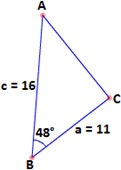Solved Examples and Worksheet for Areas of Triangles using Trigonometry
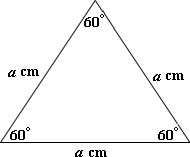
A. 19.22
B. 12.4
C. 9.61
D. 6.2
Step: 1
The side of the equilateral triangle is 4.8 cm.
Step: 2
Area of the equilateral triangle = (1 2
[Area of triangle given SAS.]
Step: 3
= 1 2
[From the figure.]
Step: 4
= 1 2 3 2 3
Correct Answer is : 9.613
A. 10.5 cm2
B. 52.92 cm2
C. 26.46 cm2
D. 8.4 cm2
Step: 1
The sides of the triangle are 6.3 cm, 8.4 cm and let θ
[Assuming θ
Step: 2
Area of Triangle = 1 2
[Area of triangle given SAS.]
Step: 3
= (1 2 θ θ
[Substitue to find the area]
Step: 4
sin θ θ
Step: 5
The area of the given triangle is maximum when the included angle is 90°.
Step: 6
At θ
[Substitute the value of Sin 90° = 1]
Correct Answer is : 26.46 cm2
A. 9 in
B. 3 in
C. 8 in
D. 7 in
Step: 1
Let the side of the equilateral triangle be a h
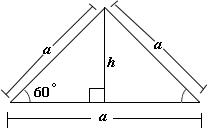

Step: 2
sin 60° = h a
[Use the sine ratio.]
Step: 3
Step: 4
[Cross - product property.]
Step: 5
The area of the equilateral triangle = (1 2
[Write the area of an equilateral triangle.]
Step: 6
= (1 2 a a 3 4 ) ( 4 h 2 3
[Substitute 2 h 3 a
Step: 7
= h 2 3
[Simplify.]
Step: 8
[The area of the equilateral triangle is given by 9 3
Step: 9
[Simplify.]
Step: 10
[Find square root on each side.]
Correct Answer is : 3 in
A. 11 in
B. 10 in
C. 5 in
D. 9 in
Step: 1
Let the side of the equilateral triangle be a h
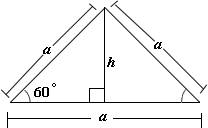

Step: 2
sin 60° = h a
[Use the sine ratio.]
Step: 3
Step: 4
[Cross - product property.]
Step: 5
The area of the equilateral triangle = (1 2
[Write the area of an equilateral triangle.]
Step: 6
= (1 2 a a 3 4 ) ( 4 h 2 3
[Substitute 2 h 3 a
Step: 7
= h 2 3
[Simplify.]
Step: 8
[The area of the equilateral triangle is given by 2 5 3
Step: 9
[Simplify.]
Step: 10
[Find square root on each side.]
Correct Answer is : 5 in
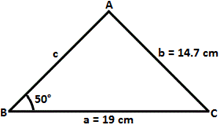
A. 103.8 cm2
B. 102.1 cm2
C. 121.2 cm2
D. 101.2 cm2
Step: 1
[Use law of Sines: Sin A a Sin B b
Step: 2
Sin A = 19 × Sin 50 o 14.7 )
Step: 3
Sin A ≈ 0.99012
[Simplify.]
Step: 4
Step: 5
[Triangle - Angle sum property.]
Step: 6
[Substitute and simplify.]
Step: 7
Area of triangle ABC = 1 2
Step: 8
= 1 2
[Substitute and simplify.]
Step: 9
Therefore, the area of the triangle ABC is ' 103.8 cm2 '.
Correct Answer is : 103.8 cm2
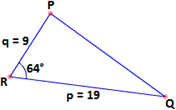
A. 72.6 cm2
B. 68.5 cm2
C. 84.2 cm2
D. 76.8 cm2
Step: 1
[Given]
Step: 2
Area of triangle PQR = 1 2 p q R
Step: 3
= 1 2
[Substitute and simplify.]
Step: 4
Therefore, the area of the triangle PQR to three significant digits is 76.8 cm2.
Correct Answer is : 76.8 cm2
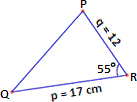
A. 69.8 cm2
B. 83.6 cm2
C. 77.4 cm2
D. 89.1 cm2
Step: 1
[Given]
Step: 2
Area of triangle PQR = 1 2 p q R
Step: 3
= 1 2
[Substitute and simplify.]
Step: 4
Therefore, the area of the triangle PQR to three significant digits is 83.6 cm2.
Correct Answer is : 83.6 cm2
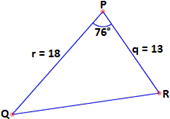
A. 127.4 cm2
B. 109.8 cm2
C. 111.9 cm2
D. 113.5 cm2
Step: 1
[Given]
Step: 2
Area of triangle PQR = 1 2 q r P
Step: 3
= 1 2
[Substitute and simplify.]
Step: 4
Therefore, the area of the triangle PQR to four significant digits is 113.5 cm2.
Correct Answer is : 113.5 cm2
A. 25 cm
B. 15 cm
C. 9 cm
D. 12 cm
Step: 1
Let the side of the equilateral triangle be a cm and the height be h
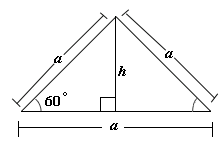

Step: 2
Sin 60° = h a
[Use the Sine ratio.]
Step: 3
[Substitute and simplify for a.]
Step: 4
Area of the equilateral triangle = 1 2
Step: 5
Step: 6
[The area of the equilateral triangle is given by 753
Step: 7
[Simplify]
Step: 8
[Apply square root on both sides]
Step: 9
Therefore, the height of the equilateral triangle is 15 cm.
Correct Answer is : 15 cm
- Congruent Triangles-Geometry-Solved Examples
- Similar Figures-Geometry-Solved Examples
- Centre and Scale Factor in Dilation-Geometry-Solved Examples
- Application of the Pythagorean Theorem-Geometry-Solved Examples
- Special Right Triangles-Geometry-Solved Examples
- Trigonometric Ratios-Geometry-Solved Examples
- Application Problems involving Trigonometric Functions-Geometry-Solved Examples
- Law of Sines and Cosines to Solve Triangles-Geometry-Solved Examples
Related Worksheet
- Triangle
